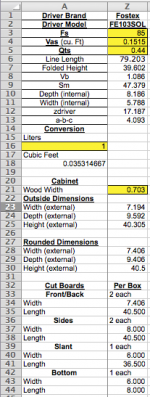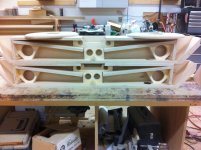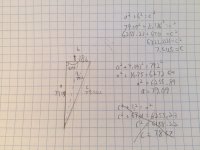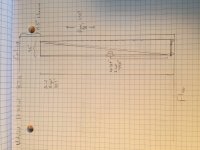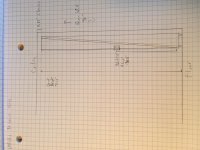What wood thickness would we recommend for a BIB with the Fostex FE103sol?
I entered the relevant information from the FE103sol manufacturer spec list into the spreadsheet from Zilla's website.
The attached screenshot shows the cabinet dimensions using 0.703" thick plywood (the 3/4" nominal maple ply available at Lowe's), but I'd rather go with a high quality Baltic birch. What thickness would you recommend, and how would that be calculated?
Thanks!
Jeff
I entered the relevant information from the FE103sol manufacturer spec list into the spreadsheet from Zilla's website.
The attached screenshot shows the cabinet dimensions using 0.703" thick plywood (the 3/4" nominal maple ply available at Lowe's), but I'd rather go with a high quality Baltic birch. What thickness would you recommend, and how would that be calculated?
Thanks!
Jeff
Attachments
If those dimensions are inches then you should be fine with 15mm BB. You’ll want to invert the BIB so the mouth loads into the floor/wall interface. But that puts the driver at a height of 17” + whatever height you choose to lift it off the floor. That is a problem. Building an unfolded one doesn’t help either. IIRC there is an alternate Zd, that might help.
dave
dave
What's the advantage to floor/wall loading?
This will be in my home office, which is 7.5'W x 15'L x 8'H. I was attracted to the original BIB design because of the corner loading that uses the walls and ceiling to extend the horn mouth. Since the speakers would be placed in the corners of the narrow wall, I thought this would make a nice stereo image.
This will be in my home office, which is 7.5'W x 15'L x 8'H. I was attracted to the original BIB design because of the corner loading that uses the walls and ceiling to extend the horn mouth. Since the speakers would be placed in the corners of the narrow wall, I thought this would make a nice stereo image.
A BIB assumes that you will have the mouth close enuff to the ceiling/wall/wall interface to act as the final part of the mouth. With a BIB this short you will only have that if you mount the box half-way (approx) up the wall. So the usual fix for a short line is to flip it over. Whichever you do you still end up with the driver at a noramlly unusable height relative to your ears.
dave
dave
One looks at the dimensions for the unbraced distances and from experience chooses a material thickness. Keep in mind different materials have different characteristics. Good 15mm is better than good 3/4” MDF for instance. Also a whole lot lighter, an important consideration for your back with a box this large (still small by BIB standards).
dave
dave
The Woden Vampr-V works with either of those as do our miniOnken. Scott’s design is tall & slim so is nearer in aspect to the BIB. Mounted in a corner you might need to attenuate the bass a bit.
Our build is on the fancy side, it can be just a tall, low cross-section rectangle.
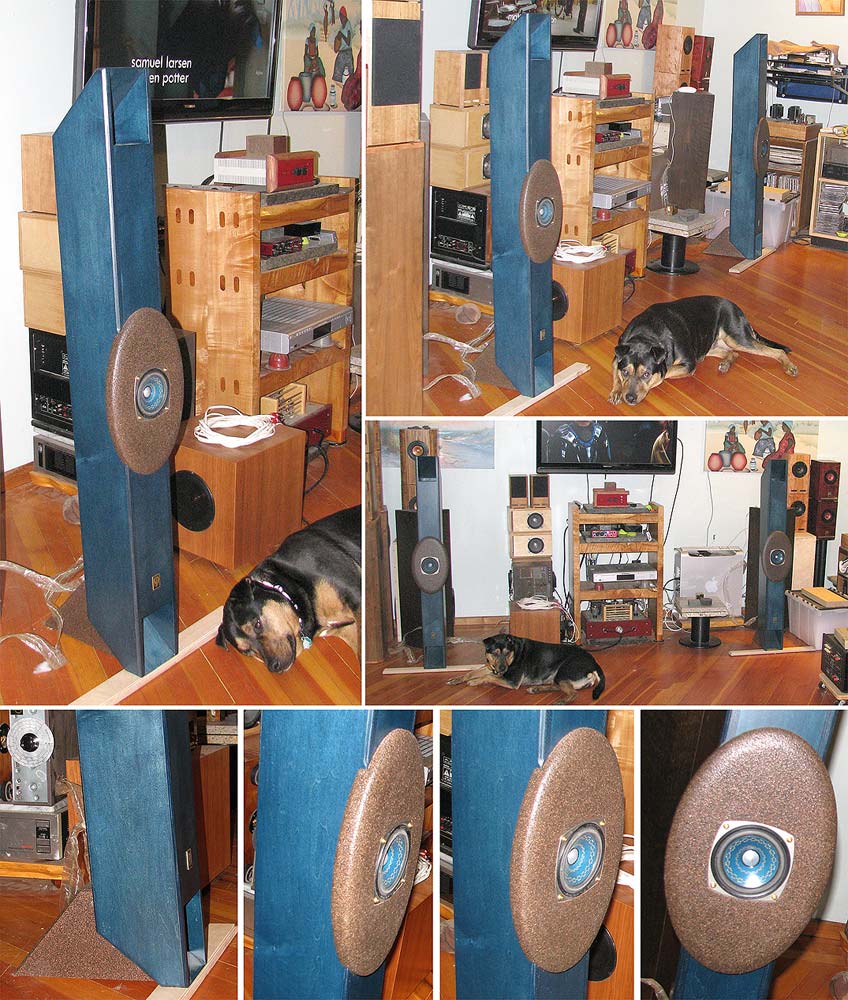
dave
Our build is on the fancy side, it can be just a tall, low cross-section rectangle.

dave
What wood thickness would we recommend for a BIB with the Fostex FE103sol?
I entered the relevant information from the FE103sol manufacturer spec list into the spreadsheet from Zilla's website.
The attached screenshot shows the cabinet dimensions using 0.703" thick plywood (the 3/4" nominal maple ply available at Lowe's), but I'd rather go with a high quality Baltic birch. What thickness would you recommend, and how would that be calculated?
Thanks!
Jeff
Go with the unfolded pipe, lower the Fs to 74 or so to get closer to the ceiling, zdriver at L*0.416 (driver height about 37"). Should work really well with your lowish ceilings.
Even absent the aesthetic flourishes of angled ends and supra-baffles, the Vampyr is a bit more fiddly a build than a BIB, but it definitely works very well.
The only BIB I've heard was DaveCan's FE108 version at one of Dave's events about a dozen(?) years ago, and as best I recall, it suffered from the lack of suitable corner boundary loading.
The only BIB I've heard was DaveCan's FE108 version at one of Dave's events about a dozen(?) years ago, and as best I recall, it suffered from the lack of suitable corner boundary loading.
Attachments
zdriver at L*0.416
There is the alternate Zd i was looking for. It is the one i used in my inverted BIB with K slot vent (IIRC).
dave
giantstairs: by unfolded pipe, do you mean something like a Voigt pipe?
chrisb: I'd really love to do a pair of Vampyr-Vs but, realistically, would need more builds under my belt before attempting those fine angles and particularly the holey braces at the ends.
planet10: so with what you're suggesting, could I use the BIB calculation for the FE103sol from Zilla's spreadsheet, but simply turn the enclosure upside down and place the driver at L*0.416?
79.203 x 0.416 = 32.95" off the ground?
Like this?: http://frugal-phile.com/boxlib/iBIBk-FE12x-map-060307.pdf
chrisb: I'd really love to do a pair of Vampyr-Vs but, realistically, would need more builds under my belt before attempting those fine angles and particularly the holey braces at the ends.
planet10: so with what you're suggesting, could I use the BIB calculation for the FE103sol from Zilla's spreadsheet, but simply turn the enclosure upside down and place the driver at L*0.416?
79.203 x 0.416 = 32.95" off the ground?
Like this?: http://frugal-phile.com/boxlib/iBIBk-FE12x-map-060307.pdf
I have built both upward and downward firing BIBs. I prefer the upward, hence my unfolded suggestion. In the big thread I remember at least one example with a photo.
I would use your numbers but increase the height to 92” or so, width and depth the same, zdriver at 0,416 or 0,5 (whichever you prefer) and shove them right in the corners. Depending on your amp you may even want to push up the qts to make them even bigger. GM explained all this back in the main thread, perhaps he will chime in.
Simple and should have lots of bass gain.
I would use your numbers but increase the height to 92” or so, width and depth the same, zdriver at 0,416 or 0,5 (whichever you prefer) and shove them right in the corners. Depending on your amp you may even want to push up the qts to make them even bigger. GM explained all this back in the main thread, perhaps he will chime in.
Simple and should have lots of bass gain.
Thanks giantstairs. I was thinking about an upward firing unfolded BIB last night and really like the idea, as they'd be a slim fit right in the corners and the driver would be at a pretty good level for when I'm sitting at my desk.
So with a ceiling height of 96" and pushing the cabinet height to 92", that leaves only 4" of space between the horn opening and the ceiling. That's enough?
I've been looking for formulae in the literature for determining distance-to-boundaries in a BIB.
So with a ceiling height of 96" and pushing the cabinet height to 92", that leaves only 4" of space between the horn opening and the ceiling. That's enough?
I've been looking for formulae in the literature for determining distance-to-boundaries in a BIB.
All those years of wondering whether the Pythagorean theorem would ever become useful in my daily life finally have their answer. Out of curiosity, I sat down to figure out the enclosure dimensions of an unfolded, upward firing BIB for FE103sol using the numbers from the spreadsheet formula and, since I was a humanities major, would appreciate feedback as to whether I'm going about this correctly (manual work attached).
L travels down the center of the horn and is 79.2"
Interior depth = 8.186"
Interior width = 5.788"
To figure out the interior front and rear baffle lengths, we can use Pythagorean theorem since the enclosure interior is a right triangle:
a = front baffle (unknown length)
b = horn opening depth (8.186")
c = hypotenuse or rear baffle (unknown length)
L = a line from the horn point to the halfway point of b (79.2")
a^2 + b^2 = c^2
For the first calculation, we assume a right triangle using L as hypotenuse. That means b is half of the interior depth from the spreadsheet, or 4.093"
* a^2 + 4.093^2 = 79.2^2
* a^2 + 16.75 = 6272.64
* a^2 = 6255.89
*a = 79.09
Now that we know the front baffle interior is 79.09", we can solve for the rear baffle by using the info from the original right triangle (where b = 8.186")
*79.09^2 + 8.186^2 = c^2
*6255.23 + 67.01 = c^2
* 6322.2381 = c^2
* 79.5125 = c
Using our preferred formula for Zd (Zd = L * 0.416), that gives a driver height of 32.95" (interior), which isn't bad.
Being realistic, let's say I use 3/4" nominal (0.703" actual) plywood, plus let's say 3/4" floor spikes on the enclosure bottom, that gives us a cabinet height of roughly 80.5".
Ceiling height is 96" so (-80.5") that leaves 15.5" of space between horn opening and ceiling. Is that too much?
L travels down the center of the horn and is 79.2"
Interior depth = 8.186"
Interior width = 5.788"
To figure out the interior front and rear baffle lengths, we can use Pythagorean theorem since the enclosure interior is a right triangle:
a = front baffle (unknown length)
b = horn opening depth (8.186")
c = hypotenuse or rear baffle (unknown length)
L = a line from the horn point to the halfway point of b (79.2")
a^2 + b^2 = c^2
For the first calculation, we assume a right triangle using L as hypotenuse. That means b is half of the interior depth from the spreadsheet, or 4.093"
* a^2 + 4.093^2 = 79.2^2
* a^2 + 16.75 = 6272.64
* a^2 = 6255.89
*a = 79.09
Now that we know the front baffle interior is 79.09", we can solve for the rear baffle by using the info from the original right triangle (where b = 8.186")
*79.09^2 + 8.186^2 = c^2
*6255.23 + 67.01 = c^2
* 6322.2381 = c^2
* 79.5125 = c
Using our preferred formula for Zd (Zd = L * 0.416), that gives a driver height of 32.95" (interior), which isn't bad.
Being realistic, let's say I use 3/4" nominal (0.703" actual) plywood, plus let's say 3/4" floor spikes on the enclosure bottom, that gives us a cabinet height of roughly 80.5".
Ceiling height is 96" so (-80.5") that leaves 15.5" of space between horn opening and ceiling. Is that too much?
Attachments
Last edited:
Length is what the SS spits out.
Just to be clear, length (L) is the median path down the horn, not baffle length, correct?
I entered manufacturer specs for FF105WK into the spreadsheet, which resulted in a longer L and taller cabinet -- about 91 inches built, with just under 5" gap between horn mouth and ceiling.
Here are some rudimentary to-scale drawings (more or less) of BIBs in-room for FE103sol and FF105WK.
FE103sol (could be raised by adding to base)
* Zheight = 34.45"
* clearance horn mouth to ceiling = 15.5"
FF105WK
*Z height = 38.8"
* clearance horn mouth to ceiling = 4.87"
How do these seem to the members here?
I will start working on iBIB drawings this evening.
Attachments
Last edited:
- Status
- This old topic is closed. If you want to reopen this topic, contact a moderator using the "Report Post" button.
- Home
- Loudspeakers
- Full Range
- FE103sol BIB
